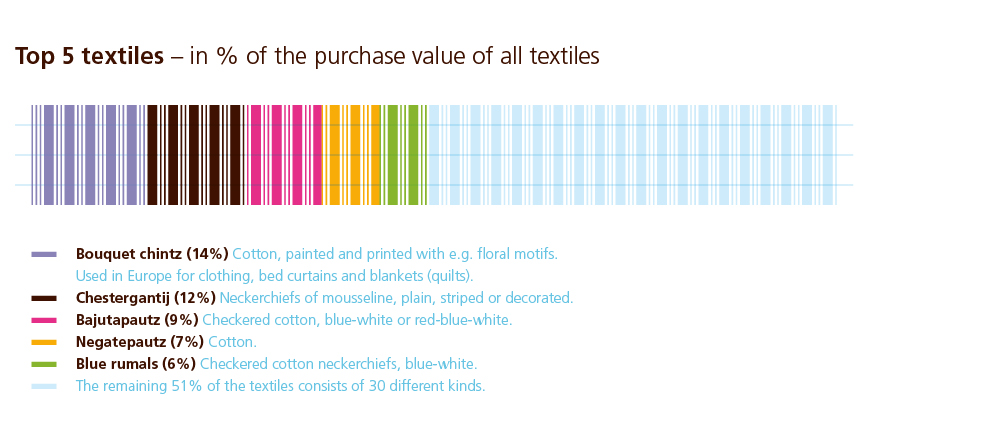Specific goods were brought along for specific areas along the coast. The goods for the Windward Coast for example, contained small barrels of gunpowder and blue salempouri, or cotton cloth.
The goods used to trade for rice and palm oil included large and small Cologne jars made of fired stone or earthenware.
The cargo goods were stored in barrels and chests on board The Unity. This can be seen in the cargo list, which doubles as a an inventory list. At the African coast the goods were brought up and readied for traded.
Textiles – Half of the Goods
Textiles were the most important of all the trading goods, taking up almost half of the total cargo purchasing price. This included 35 different types of textile. Almost all of them were made of cotton, other sorts were made of a mixture of cotton with either linen, silk or wool. The majority was indicated with the term ‘Indian’ – originally originating from India. Although India was the origin of many cloths, a lot of the fabric could soon be reproduced in Europe. The names of the fabrics therefore refer to their origin: originally made in India or in Europe. Of the textiles on board De Eenheid, 96% had an Indian appearance, only 4% had a Dutch or European design.
One of the more expensive textiles on board The Unity was the blue Salempouris, also known as blue Guinea – in fact, according to the purchase price, it was the most important of all of the bought textiles. However, the captain clearly showed that a mistake had been made in the administration. The correct price of the material should only be a third of the noted purchase price. As it turned out, the captain was right, which is why the blue Salempouris was not included in the table below: according to the correct price, the textile does not appear in the top five. The chitz was the most expensive textile. Several different kinds had been purchased, of which ‘bouquet’ chits appears to be the most important. This textile was also traded most often.
Would you like to know more about the textiles on board The Unity? Read more about the 35 different types and several samples.
Gunpowder and Guns – One Third
Gunpowder, immediately followed by guns, formed the second most important trading good. The powder was stored in barrels of a variety of sizes, and the guns included different kinds and qualities. Together, the two formed almost a third of the total purchasing price.
Liquor – A Tenth
Liquor occupied third place. Almost ten percent of the total purchasing price consisted of malt brandy and liquor. The brandy was delivered in barrels of a variety of sizes, or, like liquor, in bottles of a steckan, or a quart, which were stored in chests by 6 or 9 at a time.
Remainder
After liquor came knives and beads. The remainder of the cargo represented about five percent of the total purchasing price, and included among others copper bracelets, kettles, bowls, trumpets, mirrors, tobacco pipes, raw metal, padlocks, and wine and beer glasses.




